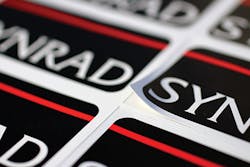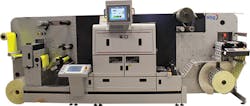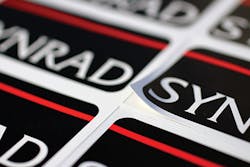Advantages and optimizations for label cutting with CO2 lasers
Technology enables cutting of multiple shapes on the fly
JUSTIN CONROY and RAJIV PANDEY
The digital printing revolution has changed the landscape of label creation significantly. With the flexibility of printed design, the need to easily change the cut shape to match has become very important. Traditionally, cutting has been done with mechanical die presses and knife slitters, where the user is locked into one design for a production shift. The cost and complex logistics of storing multiple dies make it unfeasible to have many cut shapes available. Furthermore, downtime associated with tooling changes reduces productivity metrics, which is often a deciding factor in overall cost of operations. Laser cutting with high-speed scan heads has changed this to a dynamic and easily flexible process, where cut design changes can be done on the fly via software without stopping the production line.
One subset of this application is high-speed label cutting with CO2 laser beams. Broadly, this application is classified under converting, which has the generally accepted industry definition of processes where a web-roll of material is "converted" into another form. This includes labels; perforated plastic or paper film; cut edges for box folding; and scribed, easy-to-tear food pouches, among others.
The advantages of laser-based converting are numerous. In addition to the digital flexibility of new design that can be changed on the fly, other benefits such as yield improvements derived from a non-contact method must not be overlooked, particularly as labels get thinner and with the selective capability to "kiss-cut" into a controlled depth. Also, laser-based processing has no consumables (i.e., no worn-out mechanical tools) and offers repeatable results (lasers do not get dull). For these reasons, the performance advantages offered by laser-based, digital, non-contact technology are compelling.
Label market
Market analysts are projecting a robust compound annual growth rate (CAGR) of 6% (2016-2020) driven by emerging markets and demand in end markets for pharmaceuticals, food/beverage containers, and cosmetics. While the laser-based segment is relatively small (<1% adoption) compared to traditional machine tools, it is projected to grow at faster rate because of the digital printing revolution. Many companies are now investigating the advantages of laser cutting labels.
One such company is AB Graphic International Ltd. (Bridlington, Yorkshire, England), which has been manufacturing laser-based label cutting machines for the better part of a decade. They see clear advantages in processing with Synrad CO2 lasers compared to traditional mechanical tools technology. Mike Burton, managing director of AB Graphic, says, "While laser cutting has many limitations today, the digital printing revolution is ushering in need for laser processing because it is an ideal technology to produce short-run, custom jobs. Requests can be taken online for custom designs with CAD files and quickly sent to the digital printer, followed by digital laser cutting. This end-to-end digital process saves time associated with tool and die changes, delivering fast results with total freedom. There is really no cost-effective way to satisfy customers' needs for quick turns without a laser cutter."
Laser-based processing offers a compelling value proposition. It saves customers several days to weeks of downtime in tooling changes, and gives them the ultimate flexibility. For example, a flat-bed die-cutter—the simplest of machines—not only has tooling costs upwards of $100, but also takes several days for a new tooling design. Semi-rotary, flexible die-cutters and rotary die-cutters all have the same issues, except the tooling is more expensive. Semi-rotary die cutter tooling costs several hundred dollars and has three- to five-day lead times. Full rotary die-cutter tooling costs in the range of $1000–2000, with lead times of up to two weeks. Clearly, the long lead time and inability to accommodate rapid design changes limits their capability. "Laser-based machines today make up only 1–2% of the total label cutting market," Burton adds. "The mechanical machines are ideal for long, repetitive runs and considering they cost 4–8 times less than laser machines, there is really no cost benefit in favor of laser machines. However, as the digital printing revolution led by HP Indigo machines takes shape, the demand for laser-based machines will increase over the coming years." AB Graphic designs and markets its Digilase line of label cutting machines (FIGURE 1), powered by two Synrad 200W CO2 lasers.
Optimized laser cutting of labels
In the label cutting application, for maximum throughput, achieving the best absorption into the label material by the laser energy is paramount. Most plastic and paper labels cut very well with CO2 lasers, as these material types absorb the long wavelength produced by these lasers very well. The exception is vinyl-based labels, which typically char and can create hazardous out-gassing. This material should be avoided.
For further optimization, some consideration should be given to the specific label materials and how well those materials absorb at the various laser wavelengths possible from a CO2 laser. Label sheets involve many different layers of material. There is the base paper backing, an adhesive-coated plastic or paper label, and then a varnish or laminate coating on top of that for protection. The top-most layer receives most of the laser energy first and, thus, its absorption characteristics are most important. For instance, a polypropylene label (commonly used for glue-applied labels) typically absorbs very well at 10.2–10.3μm compared to the standard 10.6μm wavelength. This translates into improved quality and throughput using the same laser power level.
Example test case setup
In this particular test, a Synrad p250 laser used in a Flyer 3D (3-axis scan head) subsystem configuration provided a large usable scan field area for processing at high speed. The Flyer 3D subsystem was configured with a 400 × 350mm field size and a 282μm focused spot size. A scan head system with high-speed galvo mirrors to steer the beam is preferable for high-speed processing. X-Y plotters are typically too slow for production-level throughput. In addition, the excellent stability of the p250 laser provides excellent consistency to the label's cut depth, so the processing results are the same, even over a long production shift.
A sheet of Synrad labels made of 0.1mm-thick polypropylene film was test-cut with the experimental setup. The p250 laser was run at a duty cycle of 45% at 50kHz PWM. This high repetition rate for the pulses merged them together to get a continuous cut in the material. The measured average power was 275W coming out of the scan head. At the standard 10.6μm wavelength, the labels cut at a speed of 4064mm/s. Because of the increased absorption of the polypropylene label material (FIGURE 2), this speed increased by 1.5X when the 10.2/10.3μm wavelength laser option was used instead. In addition, there was less wasted energy transmitted through the polypropylene layer to the backing paper underneath, reducing the scoring to a negligible amount. The labels peeled easily off the backing sheet and had clean, smooth edges with minimal melting (FIGURE 3).
Summary
CO2 lasers have a demonstrated capability in selective converting applications such as label cutting, where the flexibility to cut multiple, easily changeable shapes on the fly is needed. Furthermore, by optimizing the CO2 wavelength to the appropriate label material, further speed and quality improvement are seen over older laser systems operating at the standard 10.6μm wavelength. This is being seen in not only the lab, but in the field as well. Burton says that for AB Graphics, "going forward, we will be primarily building laser systems with the 10.2μm wavelength due to the improvements seen on our client's labels."
While this article discussed the benefits of 10.2μm vs. 10.6μm for polypropylene labels, it is worth mentioning that CO2 lasers can also operate in the 9.3μm range, which can optimally process other label film materials such as PET, commonly found in sleeve-type labels. The best quality and throughput will be achieved when the laser wavelength is matched to a project's specific film absorption characteristics.
JUSTIN CONROY([email protected]) is a laser applications engineer and RAJIV PANDEY([email protected]) is a senior product manager, both at Synrad, Mukilteo, WA; www.synrad.com.



